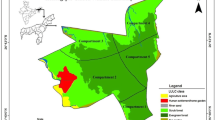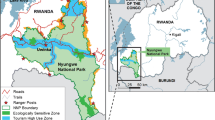Abstract
Understanding how niche differences evolve in ecologically similar species and how these differences are maintained is a fundamental question in ecology. We studied resource partitioning and niche overlap between the hoolock gibbon (Hoolock hoolock) and other frugivorous vertebrates from April 2016 to January 2018 in Satchari National Park, Sylhet, Bangladesh. We examined the differences in their diet, niche breadth, niche overlap, and characterization of patch use. We recorded feeding events of gibbons and other frugivorous vertebrates using ad libitum sampling. Gibbons consumed 76 plant species including 32 non-fig fruits and 14 figs. Twenty-one competing frugivorous vertebrate species shared 10–70% of their food species with hoolocks. Competition for fruits was intense among gibbons, macaques, and hornbills, as fruits comprised more than 50% of their diet. The niche breadth of the gibbons varied across seasons. It was lowest during the rainy season (BA = 0.39) when fruits were more readily available, and highest in winter (BA = 0.58) when gibbons were less selective due to food scarcity. The niche overlap was highest between gibbons and northern pig-tailed macaques (Ojk = 0.70), followed by gibbons and hornbills (Ojk = 0.68). Feeding heights and substrate used varied significantly between gibbons and competitors. Gibbons may minimize competition by specializing on various food resources and using different forest patches.


Similar content being viewed by others
References
Ahsan MF (1994) Behavioural ecology of the Hoolock Gibbon in Bangladesh. Dissertation, University of Cambridge, Cambridge
Ahsan MF (2001) Socio-ecology of the hoolock gibbon (Hylobates hoolock) in two forests of Bangladesh. Brookfield Zoo, compiler. The apes: challenges for the 21st century: conference proceedings, May 10–13, 2000. Brookfield Zoo, Brookfield, pp 286–99
Akers AA, Islam MA, Nijman V (2013) Habitat characterizing of Western Hoolock Gibbon by examining microhabitat use. Primates. https://doi.org/10.1007/s10329-013-0352-8
Altman J (1974) Observational study of behaviour: sampling methods. Behaviour 49:227–267
Aziz MA, Feeroz MM (2009) Utilization of forest flora by Phayre’s Leaf-Monkey Trachypithecus phayrei (Primates: Cercopithecidae) in semi-evergreen forest of Bangladesh. J Threat Taxa 1:257–262
Charnov EL (1976) Optimal foraging: attack strategy of a mantid. Am Nat 110:141–151
Chesson P (2000) Mechanisms of maintenance of species diversity. Annu Rev Ecol Evol Syst 31:343–366
Drent RH, Daan S (1980) The prudent parent: energetic adjustments in avian breeding. Ardea 68:225–252
Emlen ST (1968) The role of time and energy in food preference. Am Nat 100:611–617
Emmons LH (1980) Ecology and resource partitioning among nine species of African rainforest squirrels. Ecol Monogr 50:31–54
Estrada A, Coates-Estrada R (1985) A preliminary study of resource overlap between howling monkeys (Alouatta palliata) and other arboreal mammals in the tropical rain forest of Los Tuxtlas, Mexico. Am J Primatol 9:27–37
Feeroz MM (2011) Resource Partitioning among the Sympatric Primate Species of West Bhanugach Forest Reserve of Bangladesh. Norwegian University of Science and Technology. NO 7491, Trondheim, Norway, pp 33–43
Feeroz MM (2012) Niche Separation between Sympatric Northern Pig-Tailed Macaque (Macacaleonina) and Rhesus Macaque (M. mulatta) in Bangladesh. J Primatol 1:106. https://doi.org/10.4172/2167-6801.1000106
Feeroz MM, Islam MA (1992) Ecology and behaviour of hoolock gibbons of Bangladesh. MARC (Multidisciplinary Action Research Centre), Dhaka, Bangladesh
Fleming TH (1979) Do tropical frugivores compete for food? Am Zool 19:1157–1172
French AR, Smith TB (2005) Importance of body size in determining dominance hierarchies among diverse tropical frugivores. Biotropica 37:96–101
Ganzhorn JU (1999) Body mass, competition and the structure of primate communities. In: Fleagle JG, Janson CH, Reed KE (eds) Primate communities. Cambridge University Press, Cambridge, pp 141–157
Gautier-Hion A, Duplantier JM, Quris R, Feer F, Sourd C, Decoux JP, Dubost G, Emmons L, Erard C, Hecketsweiler P, Moungazi A, Roussilhon C, Thiollay JM (1985) Fruit characters as a basis of fruit choice and seed dispersal in a tropical forest vertebrate community. Oecologia 65:324–337
Guillotin M, Dubost G, Sabatier D (1994) Food choice and food competition among the three major primate species of French Guiana. J Zool 233:551–579
Hamilton RA, Galdikas BM (1994) A preliminary study of food selection by the orangutan in relation to plant quality. Primates 35:255–263
Hasan MK, Feeroz MM, Islam MA, Kabir MM, Begum S, Aziz MA, Sarker GC (2005) Food and feeding behaviour of hoolock gibbon (Bunopithecus hoolack hoolock) in a semievergreen forest of Bangladesh. Bangladesh J Life Sci 17:43–49
Hasan MK, Aziz MA, Alam SR, Kawamoto Y, Jones-Engel L, Kyes RC, Akhtar S, Begum S, Feeroz MM (2013) Distribution of Rhesus Macaques (Macaca mulatta) in Bangladesh: inter-population variation in group size and composition. Primate Conserv 26:125–132
Hasan MAU, Neha SA, Mineuddin MH (2018a) New locality records of the crab-eating mongoose Urva urva in Satchari National Park, Sylhet, Bangladesh. Small Carniv Conserv 56:26–30
Hasan MAU, Neha SA, Baki MA, Babu MQ (2018b) An inventory of butterfly species in relation to food sources and climatic factors influencing their diversity and richness in a semi-evergreen forest of Bangladesh. Arthropods 7:53–68
Hasan MAU, Khatun MUH, Neha SA (2018c) Group size, composition and conservation challenges of capped langur (Trachypithecus pileatus) in Satchari National Park, Bangladesh. Jagannath Univ J Life Earth Sci 4:135–153
Hurlbert SH (1978) The measurement of niche overlap and some of its relatives. Ecology 59:67–77
Islam MA, Feeroz MM (1992) Ecology of hoolock gibbon of Bangladesh. Primates 33:451–464
Kabir MM (2002) Behavioural ecology of two sympatric langur species in the semi-evergreen forest of Bangladesh. Dissertation, University of Cambridge, Cambridge
Kanwatanakid-Savini C, Poonswad P, Savini T (2009) An assessment of food overlap between gibbons and hornbills. Raffles Bull Zool 57:189–198
Krebs CJ (1989) Ecological methodology. Harper and Row, New York
Leighton M, Leighton DR (1983) Vertebrate responses to fruiting seasonality within a Bornean rain forest. In: Sutton SL, Whitmore TC, Chadwick AC (eds) Tropical rain forest: ecology and management. Blackwell Scientific, Oxford, pp 181–196
Lopez JE, Vaughan C (2007) Food niche overlap among neo-tropical frugivorous bats in Costa Rica. Rev Biol Trop 55:301–313
MacArthur RH, Pianka ER (1966) On optimal use of a patchy environment. Am Nat 100:603–609
MacKinnon JR, MacKinnon K (1978) Comparative feeding ecology of six sympatric primates in West Malaysia. In: Chivers DJ, Herbert J (eds) Recent advance in primatology, vol 1. behaviour. Academic Press, London, pp 305–321
Marshall AJ (2010) Effect of habitat quality on primate populations in Kalimantan: gibbons and leaf monkeys as case studies. In: Supriatna J, Gursky SL (eds) Indonesian primates. Springer Science+Business Media, New York, pp 157–177
Marshall AJ, Cannon CH, Leighton M (2009) Competition and niche overlap between gibbons (Hylobates albibarbis) and other frugivorous vertebrates in Gunung Palung National Park, West Kalimantan, Indonesia. In: Lappan S, Whittaker DJ (eds) The Gibbons: new perspectives on small ape socioecology and population biology. Springer, New York, pp 161–188
Martin P, Bateson P (2007) Measuring behaviour: an introductory guide. Cambridge University Press, Cambridge
McConkey KR, Ario A, Aldy F, Chivers DJ (2003) Influence of forest seasonality on gibbon food choice in the rain forests of Barito Ulu, central Kalimantan. Int J Primatol 24:19–32
Miller RS (1968) Pattern and process in competition. Adv Ecol Res 4:1–74
Monirujjaman Khan MMH (2017) Comparative activity pattern and feeding behaviour of Capped Langur (Trachypithecus pileatus) and Rhesus Macaque (Macaca mulatta) in Madhupur National Park of Bangladesh. Jahangirnagar Univ J Biol Sci 6:1–12
Neha SA, Khatun MUH, Hasan MAU (2020) Feeding behavior of the western hoolock gibbon (Hoolock hoolock) in Bangladesh: response to temporal variation of food sources. Primate Conserv 34:185–194
Palmer MW (1994) Variation in species richness: towards a unification of hypotheses. Folia Geobot Phytotaxon 29:511–530
Pianka ER (1978) Evolutionary ecology. Harper and Row, New York
Pianka ER (1986) Ecology and natural history of desert lizards. Princeton University Press, Princeton
Poulson JR, Clark CJ, Connor EF, Smith TB (2002) Differential resource use by primates and hornbills: implications for seed dispersal. Ecology 83:228–240
Pyke GH, Pulliam HR, Charnov EL (1977) Optimal foraging: a selective review of theory and tests. Q Rev Biol 52:137–157
Reed KE (1999) Population density of primates in communities: differences in community structure. In: Fleagle JG, Janson CH, Reed KE (eds) Primate communities. Cambridge University Press, Cambridge, pp 116–140
Schoener TW (1971) Theory of feeding strategies. Annu Rev Ecol Syst 2:369–404
Schoener TW (1982) The controversy over interspecific competition. Am Sci 70:586–595
Sharma R (2006) Management Plan for Satchari National Park. Nishorgo Support Project, Forest Department, Government of the People's Republic of Bangladesh
Simmen B, Hladik A, Ramasiarisoa P (2003) Food intake and dietary overlap in native Lemur catta and Propithecus verreauxi and introduced Eulemur fulvis at Berenty, Southern Madagascar. Int J Primatol 24:949–968
Singh M, Roy K, Singh M (2011) Resource partitioning in sympatric langurs and macaques in tropical rainforests of the central Western Ghats, South India. Am J Primatol 73:335–346
Stevenson PR, Quiñones MJ, Ahumada JA (2000) Influence of fruit availability on ecological overlap among four Neotropical primates at Tinigua National Park, Colombia. Biotropica 32:533–544
Subramaniam V (1981) Chemical composition and digestibility of natural and domestic food of the lar gibbon (Hylobates lar) in Malaysia. Ph.D. thesis. Universiti Pertanian Malaysia, Serdang, Selangor
Sushma HS, Singh M (2006) Resource partitioning and interspecific interactions among sympatric rainforest arboreal mammals of the Western Ghats, India. Behav Ecol 17:479–490
Umapathy G, Kumar A (2000) The occurrence of arboreal mammals in the wet evergreen forests of the Anamalai hills in the Western Ghats, South India. Biol Conserv 92:311–319
Ungar P (1996) Feeding height and niche separation in sympatric Sumatran monkeys and apes. Folia Primatol 67:163–168
Wrangham RW, Conklin-Brittain NL, Hunt KD (1998) Dietary response of chimpanzees and cercopithecines to seasonal variation in fruit abundance. I. Antifeedants. Int J Primatol 19:949–970
Yamagiwa J, Basabose AK (2006) Diet and seasonal changes in sympatric gorillas and chimpanzees at Kahuzi-Biega National Park. Primates 47:74–90
Acknowledgements
This study was supported by The Rufford Foundation. We are grateful to them for their generous contribution. No fieldwork relating to this study would have been possible without the permission, help, and cooperation of the Bangladesh Forest Department. Sincere thanks to two anonymous reviewers for their comments and suggestions in the first draft of the manuscript. We express our sincere gratitude to the Department of Zoology, Jagannath University, Dhaka, for their guidance. We are greatly indebted to Arannayk Foundation for their logistical support and help in identifying plants. We are grateful to our field assistants and local guides for their relentless support during the fieldwork. We thank Tanvir Ahmed and Md. Sabit Hasan for their cooperation in map generation.
Author information
Authors and Affiliations
Corresponding author
Additional information
Publisher's Note
Springer Nature remains neutral with regard to jurisdictional claims in published maps and institutional affiliations.
About this article
Cite this article
Neha, S.A., Khatun, U.H. & Ul Hasan, M.A. Resource partitioning and niche overlap between hoolock gibbon (Hoolock hoolock) and other frugivorous vertebrates in a tropical semi-evergreen forest. Primates 62, 331–342 (2021). https://doi.org/10.1007/s10329-021-00888-9
Received:
Accepted:
Published:
Issue Date:
DOI: https://doi.org/10.1007/s10329-021-00888-9




